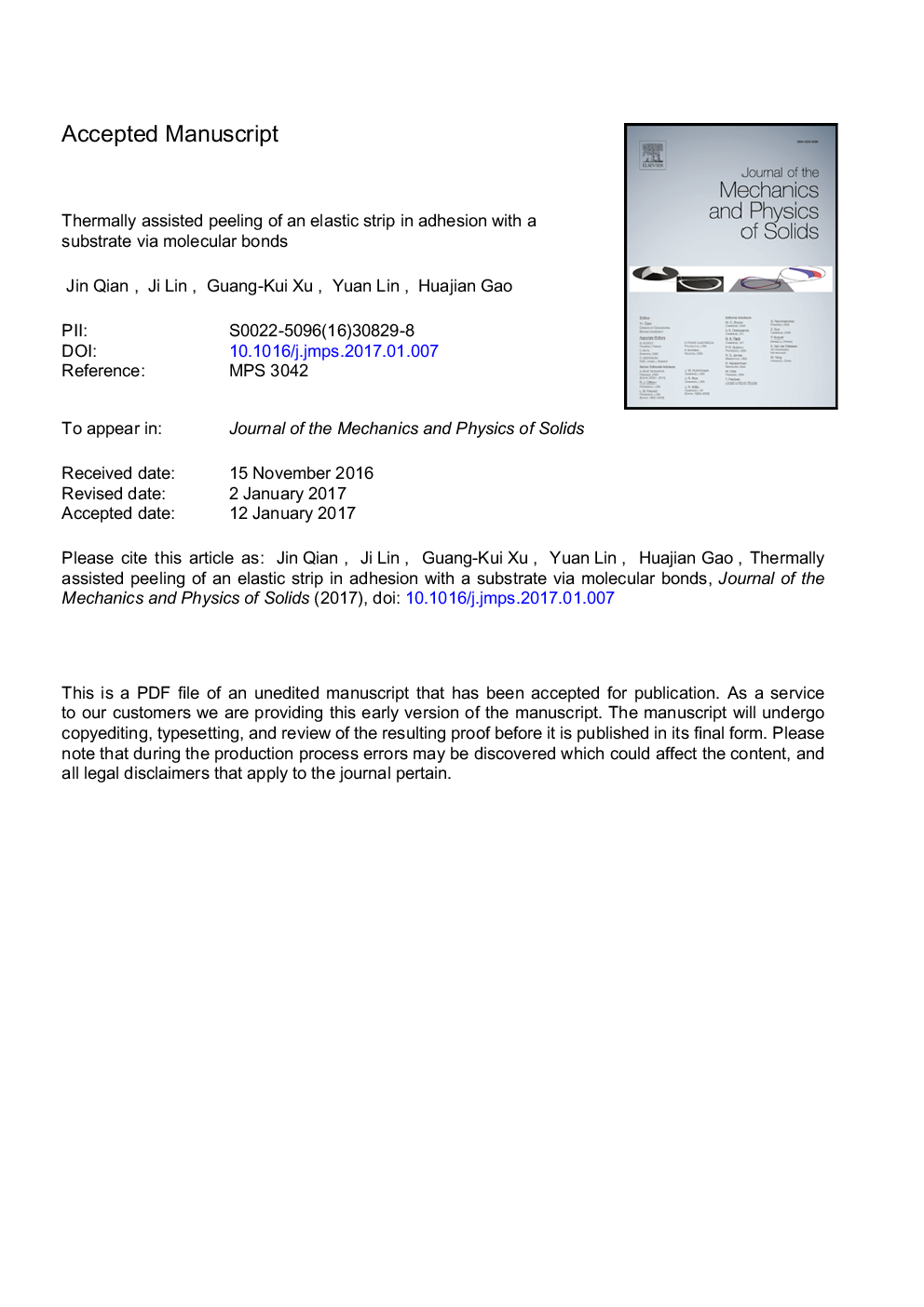| کد مقاله | کد نشریه | سال انتشار | مقاله انگلیسی | نسخه تمام متن |
|---|---|---|---|---|
| 5018208 | 1467042 | 2017 | 31 صفحه PDF | دانلود رایگان |
عنوان انگلیسی مقاله ISI
Thermally assisted peeling of an elastic strip in adhesion with a substrate via molecular bonds
ترجمه فارسی عنوان
لایه برداری از یک نوار الاستیسیته در چسبندگی با یک بستر از طریق پیوندهای مولکولی کمک می کند
دانلود مقاله + سفارش ترجمه
دانلود مقاله ISI انگلیسی
رایگان برای ایرانیان
کلمات کلیدی
پوسیدگی پیوند مولکولی، نوسان گرما، قانون انسجام، وابستگی به نرخ، از بین بردن انرژی،
ترجمه چکیده
یک مدل آماری برای توصیف لایه برداری نوار کششی در چسبندگی با یک بستر صاف از طریق آرایه ای از پیوندهای مولکولی غیر کوانتومی پیشنهاد شده است. تحت نیروی لایه برداری کششی تحمل می شود، پیوندهای مواجهه ای تحت گذر حالت انتقال نوعی در حالت اتصال قرار می گیرند، فرایندی که توسط مجموعه ای از معادلات احتمالاتی همراه با کشش، خمش و برش نوار الاستیک اداره می شود. با توجه به مقیاس انرژی مشخصی که در ارتباط با پیوند مولکولی وجود دارد، تحریکات حرارتی نقش مهمی را در کمک به فرار از پیوندهای مولکولی فرد از چاه انرژی پیوندی خود ایفا می کنند، که منجر به انتشار چهره لایه برداری به خوبی در زیر نیروی آستانه آستانه پیش بینی شده توسط نظریه های کلاسیک. مطالعه ما ارتباطی بین تغییر شکل نوار و تکامل فضایی موقت پیوندهای بین فضایی برقرار می کند و مشخص می کند که چطور عوامل مانند نیروی پوسته شدن، استحکام خمشی نوار و انرژی اتصال پیوندها بر سرعت تولید و ابعاد ناحیه فرایند اثر می گذارد. از لحاظ استحکام چسبندگی ظاهری و انرژی تخریب شده، رابطی که به وسیله پیوند متصل شده است مقاومت در برابر لایه برداری را به شیوه ای وابسته به میزان شدید دارد.
موضوعات مرتبط
مهندسی و علوم پایه
سایر رشته های مهندسی
مهندسی مکانیک
چکیده انگلیسی
A statistical model is proposed to describe the peeling of an elastic strip in adhesion with a flat substrate via an array of non-covalent molecular bonds. Under an imposed tensile peeling force, the interfacial bonds undergo diffusion-type transition in their bonding state, a process governed by a set of probabilistic equations coupled to the stretching, bending and shearing of the elastic strip. Because of the low characteristic energy scale associated with molecular bonding, thermal excitations are found to play an important role in assisting the escape of individual molecular bonds from their bonding energy well, leading to propagation of the peeling front well below the threshold peel-off force predicted by the classical theories. Our study establishes a link between the deformation of the strip and the spatiotemporal evolution of interfacial bonds, and delineates how factors like the peeling force, bending rigidity of the strip and binding energy of bonds influence the resultant peeling velocity and dimensions of the process zone. In terms of the apparent adhesion strength and dissipated energy, the bond-mediated interface is found to resist peeling in a strongly rate-dependent manner.
ناشر
Database: Elsevier - ScienceDirect (ساینس دایرکت)
Journal: Journal of the Mechanics and Physics of Solids - Volume 101, 2017, Pages 197-208
Journal: Journal of the Mechanics and Physics of Solids - Volume 101, 2017, Pages 197-208
نویسندگان
Qian Jin, Lin Ji, Xu Guang-Kui, Lin Yuan, Gao Huajian,
